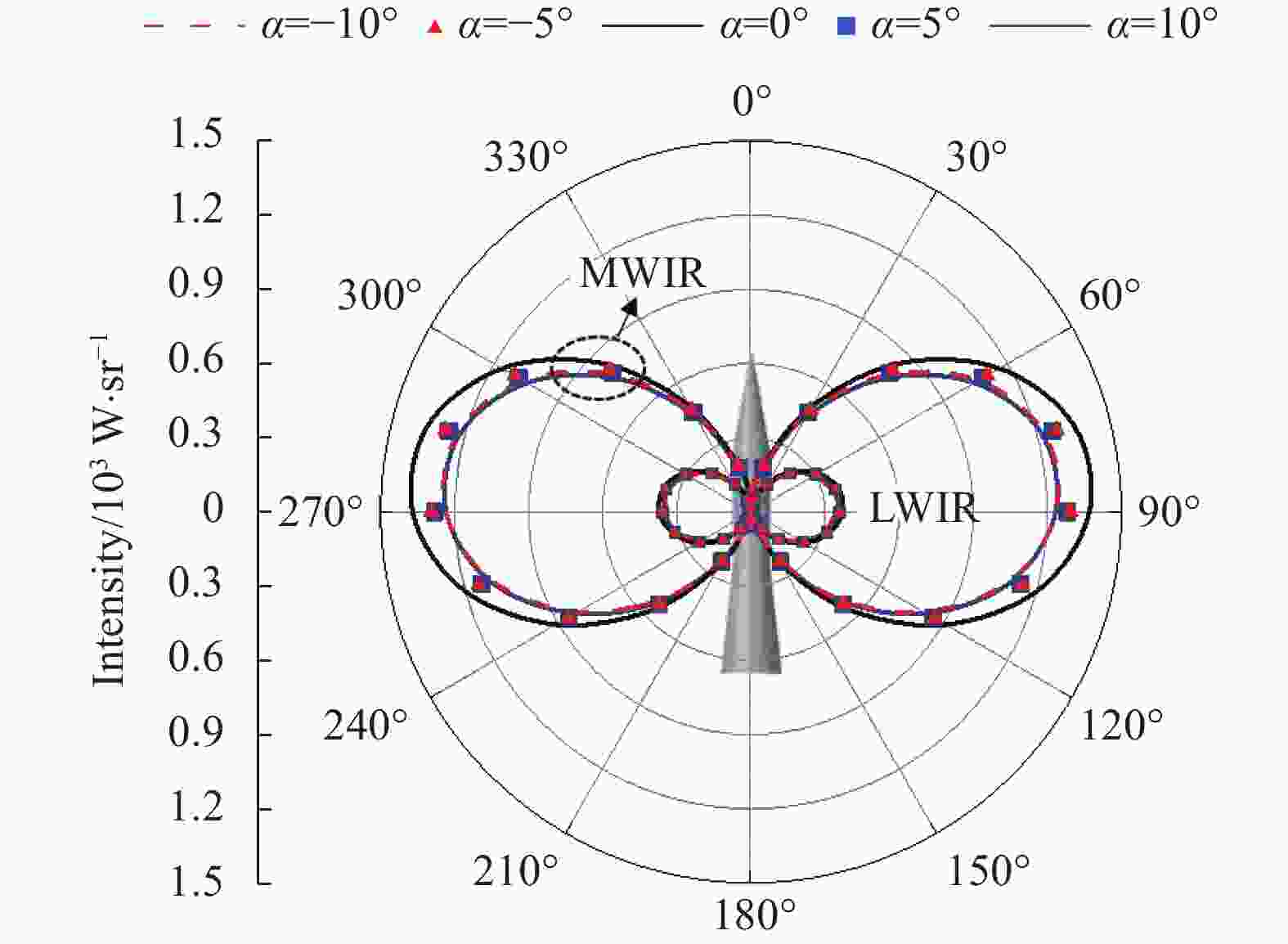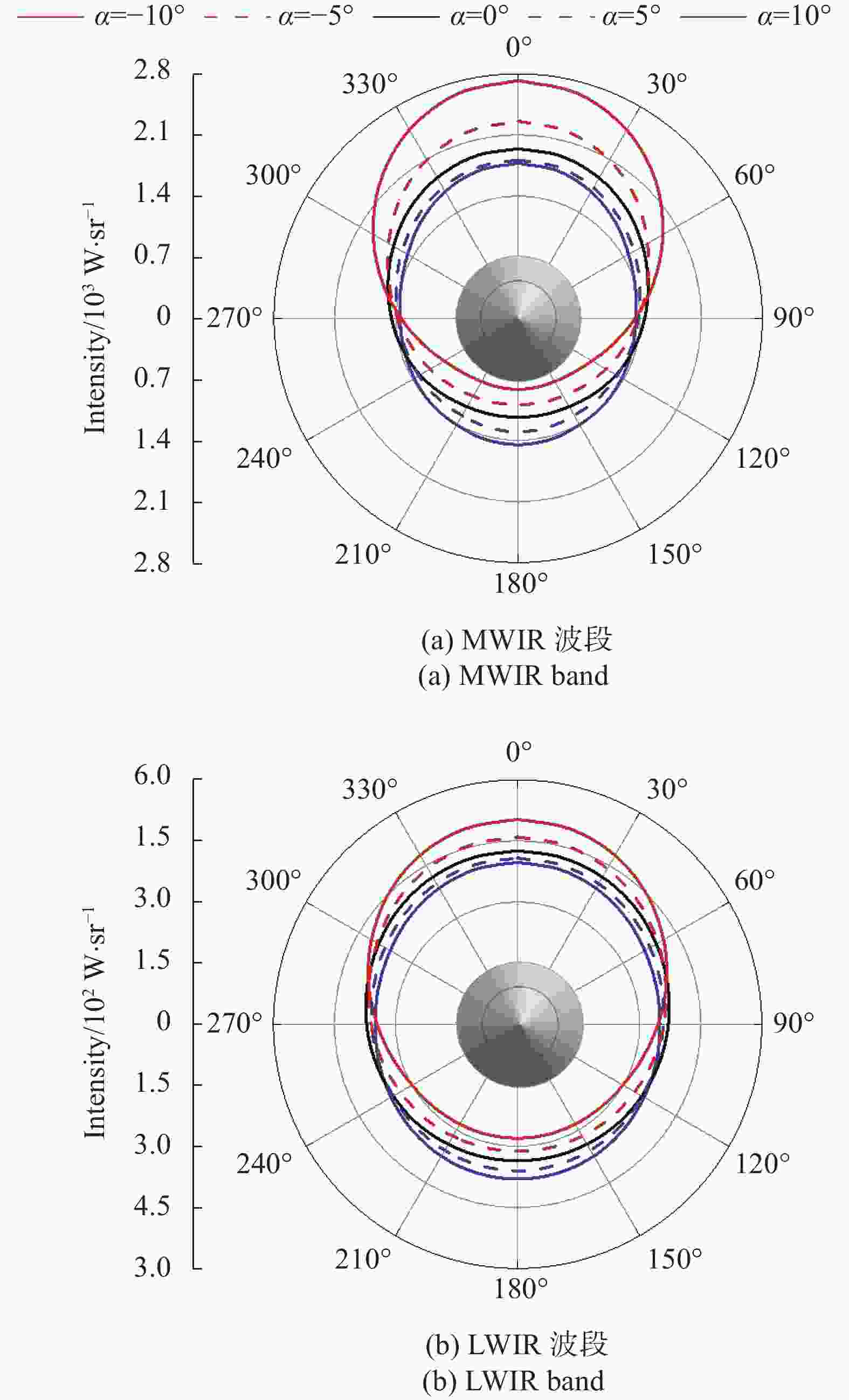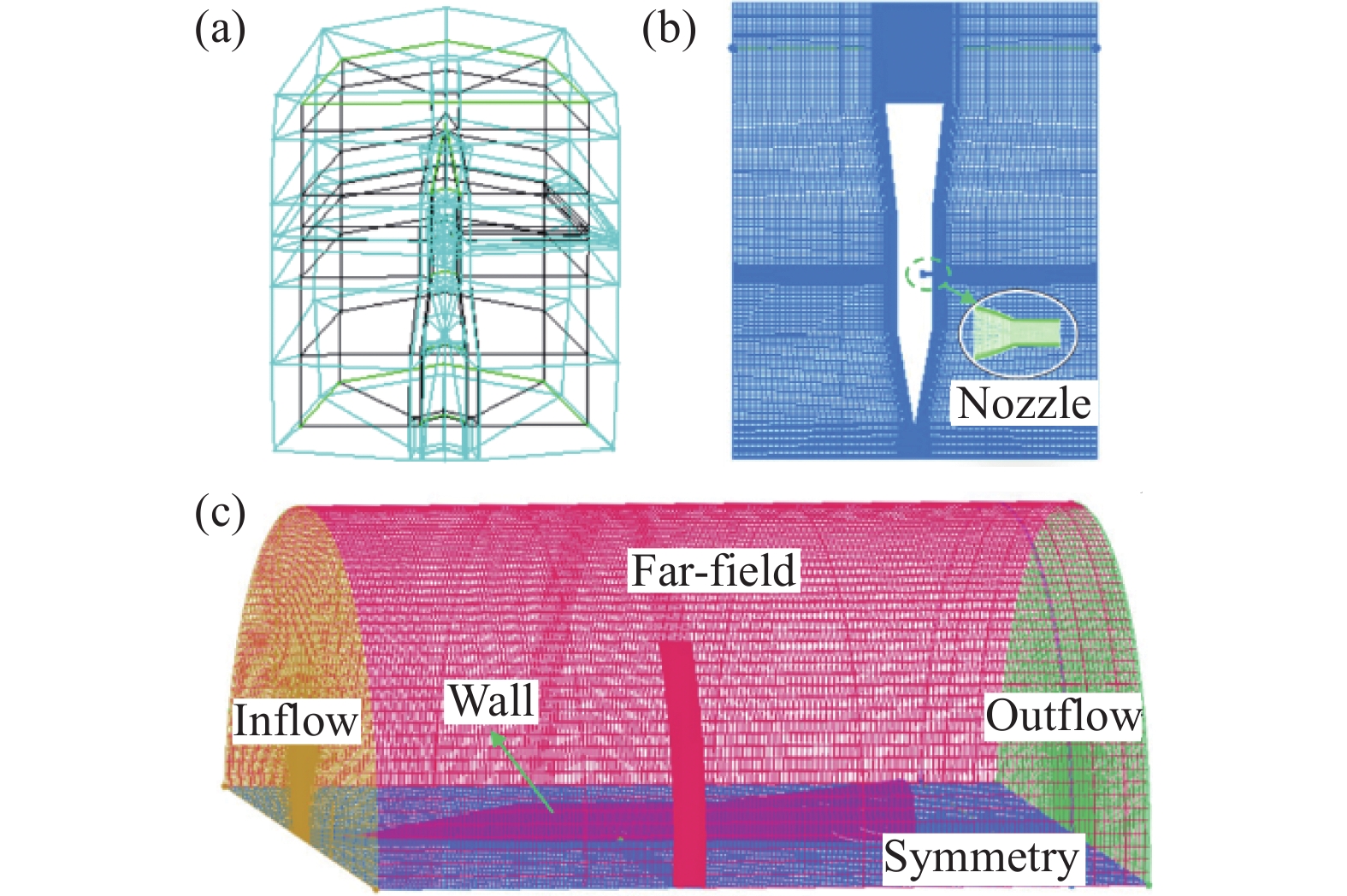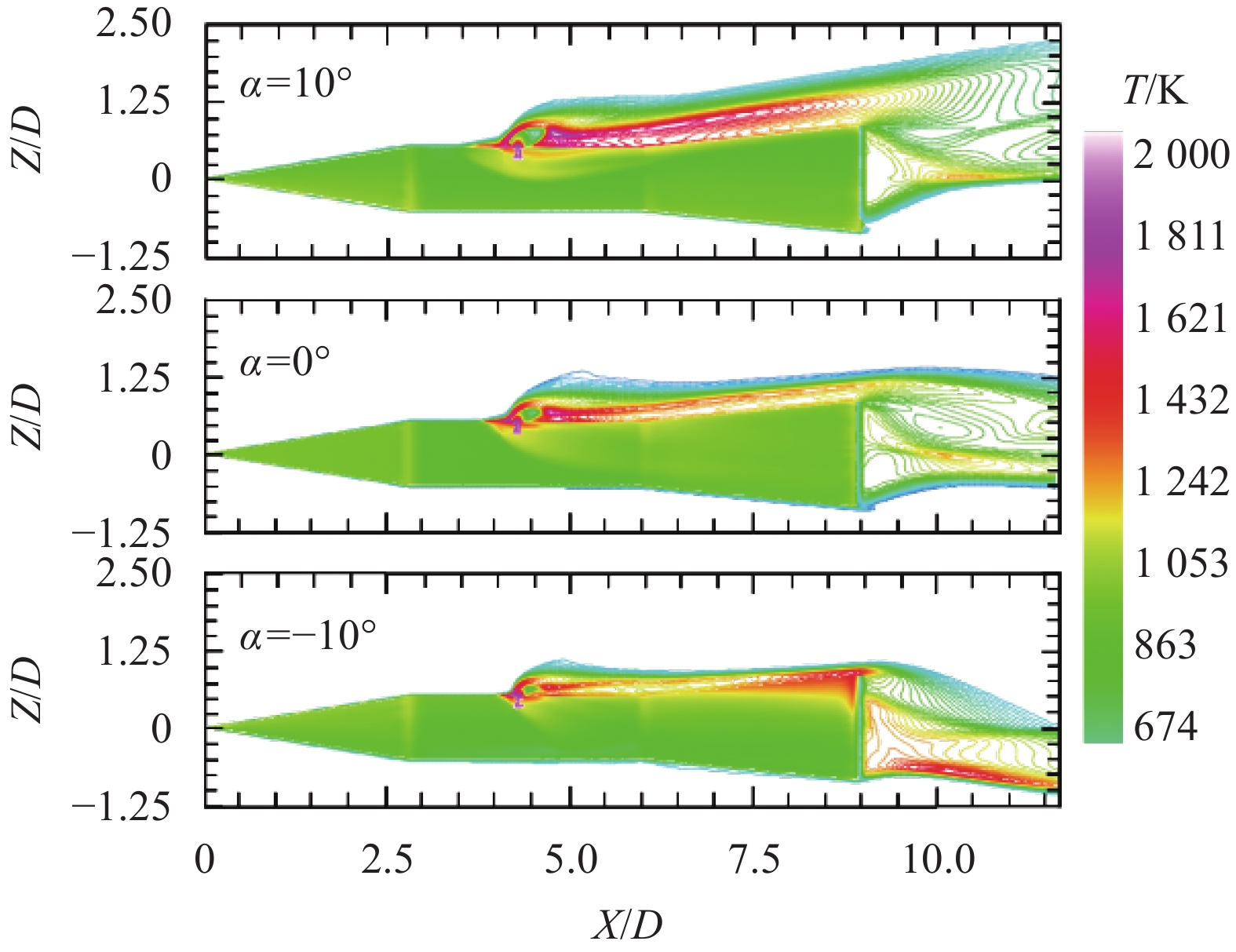-
转向和姿态控制系统(Divert and Attitude Control System,DACS)基于射流与飞行器重心位置所产生的法向力或力矩,来调整飞行器的飞行姿态,可高效地产生侧向控制力,通过侧喷射流的推力实现飞行器的转向控制,是临近空间飞行器常用的姿态控制系统[1]。
DACS通常为沿飞行器周向对称装配的脉冲火箭发动机组,在其工作过程中高温燃气喷流沿飞行器法向喷出,在高速来流作用下喷流会与绕流场交互作用,形成一系列复杂结构流场,即喷流干扰效应。在大气掺混作用下喷流部分富燃料燃气会发生复燃,使得喷流干扰过程伴随更为复杂的物理化学现象。此外,以固体推进剂或碳氢燃料为燃烧工质的DACS发动机产生的热喷流中通常含有CO2、CO和H2O等组分,在高温振-转跃迁下具有较强的红外发射能力,是目标红外辐射探测与识别的重要辐射源。
在DACS工作过程中,高温喷流亦会加热飞行器表面,改变飞行器表面的温度分布,从而影响目标的红外辐射特征。特别的,在DACS工作过程中往往伴随着攻角的出现,相较于零攻角状态,攻角变化会改变喷流干扰与飞行器加热效应,势必引起目标红外辐射特征的变化。例如,以色列成功试射了用于防御弹道导弹的Arrow-3动能拦截弹[2],动能拦截弹在机动转向拦截目标过程中呈现出了明显且强于靶标的红外辐射特征。鉴于DACS工作过程中的显著红外辐射特征,意味着在攻防对抗领域,无论是拦截弹的隐身与突防还是规避与识别任务,均提出了对高速侧喷流作用下目标红外辐射特性规律的极大关注。
近年来,对于高速来流条件下的侧喷射流研究较为广泛,在数值计算方面主要侧重于计算模型、干扰流场交互效应、气动力稳定性、飞行器气动热效应等方面[3-8]。然而,对于临近空间飞行器侧喷射流与绕流交互作用下的红外辐射特性研究较少,主要侧重于扰流作用下临近空间飞行器红外辐射特性[9-11]研究。傅杨奥骁等[12]数值分析了零攻角时侧喷流作用下典型锥柱裙飞行器的红外辐射特性。本团队已开展的助推滑翔载入飞行器在时变攻角下的目标红外辐射特性[13]和尾喷焰参与条件下的目标红外“机会”辐射特性[14]研究,以及不同攻角下火箭发动机喷焰辐射特性的研究[15]均表明攻角对飞行器本体和喷焰红外辐射特性均影响显著。然而,针对攻角对侧喷射流以及飞行器红外辐射影响规律这一关系到高速飞行器突防和隐身特性的问题尚需进一步研究。
文中以典型锥柱裙外形飞行器为研究对象,围绕攻角对热喷流下飞行器在无动力滑翔段内的红外辐射特性影响问题,建立带化学反应源项的三维纳维-斯托克斯(Navier-Stokes,N-S)方程,计算考虑复燃效应的热喷流和飞行器扰流场,结合辐射平衡壁面预测飞行器壁面温度,基于高温数据库的统计窄谱带模型建立辐射物性参数,采用视在光线法求解不含散射项的辐射传输方程,分析典型高度下攻角对热喷流场的复燃及目标在不同谱带和不同观测角度下红外辐射特性的影响。
-
在N-S方程的基础上,加入组分输运方程和有限速率化学反应模型,采用剪切应力输运(Shear Stress Transport,SST)湍流模型对方程进行封闭处理,控制方程表达式如下:[16]
式中: ρ为混合气体密度; U 为速度矢量; Γφ 和 Sφ 分别为对应于 φ 的输运系数和源项; φ 为流场通用变量。当 φ 分别为 l 、 v 、 u 、 w 、 T 、 κ、 ωs 时,上述方程分别表示连续性方程、3个方向的动量方程、能量方程、湍动能方程和耗散方程,其中, v 、 u 、 w 为3个方向的速度, T 为温度,κ为湍流耗散率,ωs 为组分 s 的质量变化率。
-
由于推进剂在火箭发动机中燃烧不完全,一定量的富燃料燃气从喷口喷出,不稳定化学组分(如H2、CO、OH等)会与空气中的氧气掺混并发生反应释放热量,即复燃效应。复燃效应可采用有限速率化学反应模型表征。由化学反应引起的组分i的质量变化率为:
式中:$ {v''_{ij}} $和$ {v'_{ij}} $表示反应物生成物的化学计量系数;$ {k_{fj}} $和$ {k_{bj}} $分别表示化学反应的正向速率常数和反向速率常数;ρij为第i个反应物或第j个反应生成物的密度;Wi为组分i的分子量。
文中计算考虑了9种主要化学组元,包括O2、N2、H2、CO、CO2、H2O、OH、H和O。化学反应动力式共涉及10个基元反应,详细反应机理参考文献[16]。
-
飞行器壁面热流主要来源于绕流场气动加热,可由如下公式表示:
式中:$ {q_{conv}} $为对流热流;$ {q_s} $为组分s的扩散热流;n表示壁面的法向向量。
在不计结构导热情况下,在垂直壁面方向上壁面向外辐射的热流为:
式中:ε为表面发射率;σ为斯蒂芬-玻耳兹曼常数,值为5.67×10−8 W/(m2·K4)。
根据辐射平衡壁面条件,进入壁面的净热流与壁面辐射散热热流达到平衡,即:
由此,壁面温度可通过与流场计算同步迭代求解获得。
-
对于高温壁面,辐射强度取决于温度与表面发射率。由普朗克辐射定律可计算飞行器表面微元面的辐射强度,表达式为:
式中:T为温度;λ为波长;ε为表面发射率,取为定值0.65[17];第一辐射常数C1=3.741 8×10−16 W·m2;第二辐射常数C2=1.438 8×10−2 m·K。
-
统计窄谱带计算方法是基于Curtics-Godson近似法[18]的单线组模型[19],用于求解光谱计算所需的辐射物性参数。假设在一定波数区间(5~25 cm−1)内,谱线的强度和位置存在统计规律,可根据该规律推导出某波数区间内的平均透过率。透射过一段行程长度为L、气体体积分数为f、总压强为p的等温、均质气体,某一中心波数为η的谱带平均透过率为:
其中,
式中:${\overline k_\eta }$、${\overline\gamma _\eta }$、${\overline\delta _\eta }$分别表示平均吸收系数、平均半宽和平均间距。主要分子(如CO2、CO、OH、HCL、NO、H2O等)在300~3000 K温度范围内的参数信息可以从高温数据库[18]中获得。
-
文中绕流场及喷焰组分均为气相,忽略粒子散射效应,辐射传输方程可简化为[20]:
式中:s和$\vec s$分别为辐射传输行程和光程向量;λ为波长;Iλ和Ib,λ分别表示光谱辐射强度和黑体光谱辐射强度;${\kappa _\lambda }$为混合气体的吸收系数。
采用视在光线法求解上述方程。沿LOS的辐射强度可以表示为:
式中:$I_{\Delta \eta }^i$表示第i层介质处波数为η的光谱辐射强度;τ为光谱透射率。
在η2-η1波数范围内的辐射强度可以表示为:
-
文中以典型锥柱裙外形飞行器[7,21]为研究对象,飞行器由锥体(长度2.8D)、柱体(直径D,长度3.2D)和圆台形裙体(最大直径为1.655D、长为3D)组成,如图1所示。一个直径为0.1D的喷口位于距飞行器鼻端4.3D的柱体截面上,喷管轴线与飞行器轴线相垂直。
-
考虑到飞行器模型的对称性,选取1/2部分进行建模。如图2(c)所示,计算域设定为直径为10D的半圆柱体,前端面距离飞行器鼻端0.75D,后端面距离飞行器底面2.75D。采用ICEM-CFD软件进行网格划分,计算域共分为86个block(见图2(a)),网格数目约为684万。为保证激波捕获的准确性,在飞行器周围和侧喷流出现的区域进行网格加密处理(见图2(b)),其中在边界层区域的第一层网格间距设置为2×10−6D,法向网格间距增加比为1.1。且开展了网格无关性验证。
-
对飞行器绕流场及侧喷射流进行仿真计算,来流入口和远场边界采用均匀压力和温度的自由流条件;出口边界指定环境压力;飞行器表面设置为辐射平衡壁面;喷口施加多组分温度边界条件,燃气组分的质量分数参考文献[21],分别取为CO2=0.382、CO=0.355、N2=0.141、H2O=0.105、H2=0.017,射流压力比(PR=Pj/P∞)取为130。各项参数及来流中组分质量分数如表1所示。
Parameter Value Ma∞ 5 P∞/Pa 5.53×103 T∞/K 216.65 Tj/K 2058 O2 0.234 N2 0.766 Table 1. Simulation conditions
-
假设射流方向为Z轴正方向,飞行器鼻端指向X轴正方向,则X-O-Z平面为飞行器对称面。设Y-O-Z平面为探测面1,X-O-Y平面为探测面2。当侧滑角为0°时,即飞行器速度矢量与X-O-Z平面平行时,飞行器中心轴与来流之间的夹角为飞行器攻角,用符号α表示。当来流速度矢量方向在Z轴上投影指向正半轴时,α为正,反之α为负。探测角度通过观测角天顶角θ和圆周角φ描述。如图3所示,θ为观测方向向量与Z轴之间的夹角,φ为观测方向向量在X-O-Y平面上的投影与X轴之间的夹角。例如,(90°, 0°)表示正前方观测,(90°, 90°)表示正侧方观测。
-
为了验证文中采用物理模型的可靠性,分别选用:1)以Gnemmi等人[21]开展的超声速来流与侧喷射流相互作用风洞试验及数值模拟进行流场计算模型验证。试验模型为典型锥柱裙飞行器,射流为冷喷流,试验模型表面压力系数分布计算条件在表2中给出。图4(a)给出了文中计算结果与参考文献的对照曲线,计算结果与实验结果吻合良好,验证了文中绕流场及侧喷流计算模型的可靠性。2)以Avital等人[22]开展的BEM-Ⅱ火箭发动机喷焰地面红外辐射测量试验进行高温射流红外辐射模型验证。BEM-Ⅱ推进剂为无铝HTPB/AP,燃烧产物的主要成分包含CO、CO2和H2O等侧喷射流的主要组分。喷管几何和热力特性参数、环境参数及光谱数据在文献[23]中详细给出。图4(b)为计算与试验喷焰光谱辐射强度对照,喷焰红外辐射结果与参考数据吻合较好,验证了辐射物性参数计算模型和辐射传输方法的可靠性。
Parameter Value Ma∞ 3 P∞/Pa 1.949×104 T∞/K 103.2 PR 50 Tj/K 223 Table 2. Wind tunnel test conditions
-
为了探究攻角对侧喷射流流场的作用,在图5中分别给出了α=10°、0°和−10°三个攻角下的稳态流场和壁面温度分布云图。可以看出,攻角变化引起射流形态及壁面温度分布的变化明显。与α=0°相比,α=10°时侧喷射流马赫盘增大,射流向上扩张且高温面积增大,对壁面气动加热作用减弱。然而,α=−10°时马赫盘减小,射流被压缩到一个细长形状的有限区域内,对壁面的加热作用增强,飞行器尾部出现局部高温,较α=0°的温度升高500 K左右,且尾流高温面积显著增大。
此外,典型高度下侧喷射流的组分分布如图6所示。考虑到H2O与CO2的质量分数分布类似,仅给出CO2和CO的分布云图。可以看出,攻角明显改变了侧喷射流的组分分布。α=10°时,CO2组分高浓度区主要集中在飞行器上方,较α=0°扩大了组分的分布范围。在α=−10°时,由于来流对喷流的强烈交互作用,高浓度CO2被压缩且拓延至尾流区域。然而,CO浓度分布则呈现出明显不同。随着攻角由正变负,CO高浓度区域变小,且均出现在飞行器上方。不稳定产物CO和稳定产物CO2浓度分布表明因攻角出现引起的射流交互效应改变了燃气的化学反应程度。
-
射流作用时对飞行器壁面进行加热从而产生局部热点,复燃越剧烈加热作用愈强。为了研究射流复燃对飞行器流场的影响,分析了20 km飞行高度下近壁气体的温度和组分浓度分布,如图7所示。由图可知,化学反应热流作用下的流场温度及组分CO2、H2O质量分数均高于冻结流作用,O2质量分数低于冻结流作用,表明侧喷流的复燃效应存在。

Figure 7. Distribution curves of flow field parameters along the wall-attached line with/without chemical reaction flow
为了进一步研究攻角变化对射流复燃的影响,图8给出了侧视(θ=90°, φ=90°)观测角度下、MWIR (Medium Wave Infrared,3~5 μm)波段内飞行器总辐射积分强度随攻角的变化。α=0°时化学反应流与冻结流作用下辐射强度差值为49.6 W/sr,复燃效应对目标辐射强度提高了约3.5%。随着攻角由负变正,射流复燃程度减小,具体表现为:α=−10°时化学反应流与冻结流作用下辐射强度差值提高约145%,α=10°时降低约31.5%。由此可见,攻角变化会在一定程度上改变射流形态和气体组分浓度分布,从而改变流场复燃程度及辐射强度。
-
飞行器的红外辐射强度取决于温度和发射率,图5表明攻角对飞行器壁面的温度分布影响较大。基于此,图9给出了飞行器在俯视(θ=0°, φ=90°)及侧视(θ=90°, φ=90°)观测角度下1~12 μm波段内的本体辐射光谱。飞行器的红外辐射光谱服从普朗克黑体发射定律。在文中指定的飞行条件下光谱强度峰值集中在MWIR波段内。俯视观测角度下,当攻角为负时,光谱辐射强度随攻角的增大而增大;当攻角为正时,光谱辐射强度随攻角的增大而减小;且负攻角对光谱辐射强度的影响远大于正攻角,具体表现为:α=−10°时光谱辐射强度峰值较α=0°增强62.4%,α=10°时降低13.3%,这是由于负攻角下来流压缩作用增强,射流交互作用及射流对壁面的加热作用远远强于正攻角工况。侧视观测角度下,α=10°/−10°较α=0°偏低约10.3%。因此攻角变化对临近空间飞行器本体红外辐射影响较大。
由于大气窗口的存在,工程中关注的光谱波段通常是MWIR波段和LWIR (Long Wave Infrared,8~12 μm)波段。为了分析临近空间飞行器的谱带积分强度随观测角度的变化规律,图10和图11分别给出了由天顶角θ和圆周角φ描述的两个典型探测面下的辐射积分强度分布。
由图10(a)可知,MWIR谱带内,俯侧视(θ=0°~90°, φ=90°)观测角度下本体的辐射强度明显高于仰侧视(θ=90°~180°, φ=90°),俯视(θ=0°, φ=90°)观测角度下辐射积分强度最强,仰视(θ=180°, φ=90°)观测角度下最弱,α=0°时分别为1836.6 W/sr和1121.1 W/sr。这是由于喷口附近壁面受射流加热作用显著,导致该区域壁面温度升高,辐射增强。攻角变化对飞行器辐射积分强度分布影响较大,当攻角为负时,俯视下辐射积分强度随攻角的增大而增大,仰视下辐射积分强度随攻角的增大而减小,与图9所示变化规律相对应;攻角为正时,辐射积分强度变化规律与负攻角相反。如图11所示,在圆周角φ描述的探测面2内,侧视(θ=90°, φ=90°)观测角度下辐射积分强度最强,后视(θ=90°, φ=180°)观测角度下最弱,α=0°时分别为1370.3 W/sr和7.6 W/sr。攻角引起各观测角度下的辐射强度降低,且下降程度相近。
在相同探测面上,两个谱带内辐射积分强度随观测角度及攻角的变化呈现出相似的分布规律,但辐射强度值差异明显,近似符合MWIR为LWIR 4倍的规律。由此可知,临近空间飞行器的本体辐射强度与谱带和观测角度密切相关,攻角变化会对辐射积分强度数值大小和分布规律产生较大影响。
-
飞行器的总辐射强度来自于本体辐射和高温气体辐射,攻角对飞行器温度分布及组分浓度分布均有影响,本节着重分析飞行器在不同攻角下的总辐射特性。图12为临近空间飞行器在俯视(θ=0°, φ=90°)观测角度下1~12 μm范围内的总辐射光谱。
目标总辐射光谱除了存在2.7 μm (H2O)和4.3 μm(CO2)两个特征峰值外,光谱辐射强度分布与图11基本一致,且数值大小相近。这是因为负攻角飞行状态下,来流压缩作用增强,射流交互作用及射流对壁面的加热作用较为强烈;正攻角飞行状态下,来流压缩作用较弱,射流扩张并遮挡部分高温壁面。由此可知,侧喷射流红外辐射在2.7 μm波段与本体强度相当,在4.3 μm波段强度峰值明显高于本体,其他波段辐射主要来自于本体。
临近空间飞行器在MWIR和LWIR波段内的总辐射积分强度随观测角度的变化如图13和图14所示。由图可知,飞行器总辐射分布规律及攻角变化对其影响与本体辐射基本一致,差异体现在总辐射数值大小略高于本体辐射。在MWIR谱带内,α=0°时俯视(θ=0°, φ=90°)与后视(θ=90°, φ=180°)观测角度下辐射积分强度分别为1942.7 W/sr和21.9 W/sr。由此可知,H=20 km时临近空间飞行器的总辐射主要来自于本体。
-
文中数值研究了攻角对临近空间飞行器侧喷射流红外特征的影响,以典型锥柱裙外形飞行器为研究对象,分析了20 km典型高度下攻角对飞行器及侧喷射流的流场参数和红外辐射特性的影响,包含流场温度和主要组分、光谱辐射强度以及光谱带内辐射积分强度分布。研究结果表明:
1)攻角通过影响侧喷射流的形态和与来流交互作用程度来改变燃气复燃效应,从而进一步影响组分浓度含量和壁面温度的分布;复燃效应对目标中波波段内红外辐射强度提高了约3.5%;α=−10°时辐射强度提高程度较α=0°增强约145%,α=10°时降低约31.5%,表明攻角的出现会显著影响射流复燃程度,进而影响辐射强度。
2)在MWIR波段内,飞行器本体辐射积分强度在俯视观测角度下最强,正后视观测角度下最弱,且前者是后者的240余倍;LWIR波段辐射积分强度约为MWIR波段的1/4;侧喷流在2.7 μm和4.3 μm两个特征峰值波段辐射较为明显,其他波段内目标辐射主要来自飞行器本体。表明目标辐射强度强烈依赖于波段及观测角度。
3)在飞行器周向探测面1内,当α=−10°时,俯视下总辐射积分强度较α=0°增强约40.2%,仰视下降低约28.1%;当α=10°时,俯视下总辐射积分强度较α=0°降低约8.6%,仰视下增强约27.8%;在飞行器水平探测面2内,当α=−10°/10°时,总辐射积分强度降低约7.5%,当α=−5°/5°时,总辐射积分强度降低约4.8%。表明攻角会对各观测角度下的目标辐射强度造成显著影响,飞行器周向探测面内负攻角影响显著强于正攻角,飞行器水平探测面内大攻角影响强于小攻角。
Numerical simulation of infrared radiation characteristics of near-space aircraft side jet due to angle of attack
doi: 10.3788/IRLA20230176
- Received Date: 2023-03-30
- Rev Recd Date: 2023-10-09
- Publish Date: 2024-01-25
-
Key words:
- near-space aircraft /
- side jet /
- jet interference effect /
- infrared radiation /
- angle of attack
Abstract:























 DownLoad:
DownLoad:












